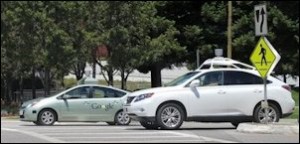by James A. Bacon
Nat Bottingheimer, a former executive with the Washington Metropolitan Area Transit Authority (WMATA), has been asking the same kinds of questions that I have about the impact of self-driving cars (SDCs) on transportation policy and human settlement patterns. Writing in Greater Greater Washington, he urges transportation planners to begin thinking about the potential impact of SDCs on everything from the demand for highways and mass transit to ride sharing and parking. Says he: “Planners and place-making advocates will need to step up their game.”
In my previous cogitations, I had focused mainly on two potential impacts: (1) reducing the perceived cost of long-distance commuting by allowing drivers to spend time on non-driving tasks like reading email and surfing the web, and (2) enhancing the advantages of shared car-ownership and shared car-ridership services that allow more people to live car-free lifestyles. The implications, to the limited extent that I had thought them through, pointed to a taffy-pulling effect on the urban form that would favor high-density communities in the urban core and low-density communities on the metropolitan periphery.
Bottingheimer raises other issues. They include (with my editorial elaborations):
- Highway capacity. If SDCs can travel faster at closer distances, the potential exists to increase highway capacity without the need to add new lanes. Asks Bottingheimer: “How can planners today [ensure] that scarce infrastructure dollar are spent on things that might be less needed in the near future?”
- Smart intersections. Could coupling SDCs with “smart” traffic lights make it possible to increase the through-put of intersections without the need for widening?
- Complete streets. Can SDCs, with their advanced collision-avoidance technologies, make it easier to design intersections that accommodate a mixing of cars, pedestrians and bicycles?
- Mass transit. Will SDCs erode the demand for transit, especially in low-density settings? Conversely, will driverless buses enhance the economics of transit? (For that matter, will driverless minibuses make jitney services a winning proposition?)
- Paratransit. Will SDCs increase mobility for the elderly and handicapped, populations that cannot drive themselves? If so, how will that impact the demand for paratransit services?
- Parking. What impact will SDCs have on park-and-rides if drivers let their cars drop them off at a destination and then drive themselves home? Could SDCs improve parking utilization when combined with emerging smart-parking technologies that identify empty spaces and vary the parking rate with supply and demand?
American states and municipalities spend billions of dollars a year building transportation infrastructure — streets, roads, highways, mass transit, sidewalks, bike lanes, parking. Those investments typically have life cycles of 30 years or more. Yet, as a study by IHS Automotive predicts, cars capable of assuming all driving functions will be hitting the highways by 2025, only 11 years from now.



